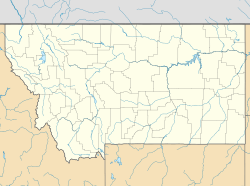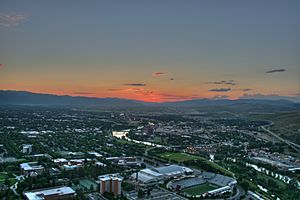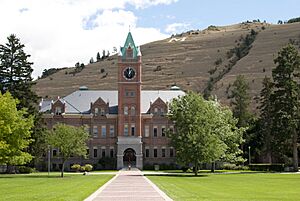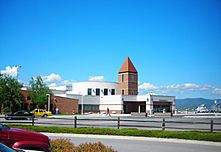Missoula, Montana facts for kids
Quick facts for kids
Missoula, Montana
|
||
|---|---|---|
 |
||
|
||
| Nicknames:
The Garden City, River City, Zootown (informal)
|
||
| Motto(s):
"The Discovery Continues"
|
||
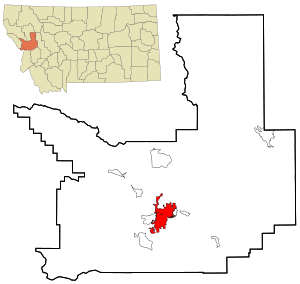
Location within Missoula County and the state of Montana
|
||
| Country | United States | |
| State | Montana | |
| County | Missoula | |
| Founded | 1866 | |
| Incorporated (town) | March 8, 1883 | |
| Incorporated (city) | March 12, 1885 | |
| Founded by | ||
| Government | ||
| • Type | Mayor–council | |
| • Body | Missoula City Council | |
| Area | ||
| • City | 35.00 sq mi (90.6 km2) | |
| • Land | 34.81 sq mi (90.2 km2) | |
| • Water | 0.19 sq mi (0.5 km2) | |
| • Urban | 45.43 sq mi (117.7 km2) | |
| • Metro | 2,618 sq mi (6,780 km2) | |
| Elevation | 3,209 ft (978 m) | |
| Population
(2020)
|
||
| • City | 73,489 | |
| • Estimate
(2023)
|
77,757 | |
| • Rank | US: 475th (2020) | |
| • Density | 2,233.50/sq mi (862.36/km2) | |
| • Metro | 117,922 (US: 319th) | |
| Demonym(s) | Missoulian | |
| Time zone | UTC−7 (Mountain) | |
| • Summer (DST) | UTC−6 (Mountain) | |
| ZIP Codes |
59801–59804, 59806–59808
|
|
| University of Montana ZIP Code |
59812
|
|
| Area code | 406 | |
| FIPS code | 30-50200 | |
| GNIS feature ID | 0787504 | |
Missoula (pronounced mih-ZOO-lə) is a vibrant city in Montana, United States. It's the main city of Missoula County. The city sits where the Clark Fork River meets the Bitterroot and Blackfoot rivers. It's also surrounded by five mountain ranges, earning it the nickname "hub of five valleys."
In 2020, about 73,489 people lived in Missoula. By 2023, this number grew to an estimated 77,757. Missoula is the second-largest city in Montana. It's also home to the University of Montana, a well-known public research university.
European settlers first arrived in the Missoula area around 1858. The city was officially founded in 1860 as the Hellgate Trading Post. By 1866, the settlement moved and was renamed "Missoula Mills," later shortened to Missoula. This new location helped supply settlers traveling the Mullan Road. Fort Missoula was built in 1877 to protect these new residents.
When the Northern Pacific Railway arrived in 1883, Missoula grew quickly. The local lumber industry also boomed. In 1893, Missoula was chosen for Montana's first university. For the next 100 years, lumber and the university were the main parts of Missoula's economy.
By the 1990s, the lumber industry slowed down. Today, Missoula's biggest employers are the University of Montana, local public schools, and the city's two hospitals. Missoula has lots of parks, trails, and open spaces. Mount Jumbo nearby is even home to elk and deer in winter. The city also has Montana's oldest and largest breweries. Jeannette Rankin, the first woman in the U.S. Congress, was a famous resident.
History of Missoula
How Missoula Began and Grew
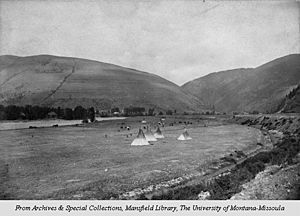
People have lived in the Missoula Valley for a very long time, possibly as far back as 12,000 years ago. From the 1700s to the 1850s, Native American tribes like the Salish, Kootenai, and Blackfeet used the land. They often traveled through the valley to hunt bison on the eastern plains. This sometimes led to conflicts. The narrow valley entrance was called "Gate of Hell" by French fur trappers because of past battles. This name stuck until 1866 when it became "Missoula."
The Lewis and Clark Expedition were the first U.S. citizens to visit the area. They stopped at Traveler's Rest nearby in 1805 and again in 1806. In 1860, a trading post called Hell Gate Village was set up west of today's downtown. It served travelers on the Mullan Road, the first wagon road across the Rocky Mountains. The settlement moved in 1864 to its current spot for better access to water for mills.
The new "Missoula Mills" became the main economic center, replacing Hell Gate Village as the county seat in 1866. The name "Missoula" comes from a Salish word meaning "place of frozen water." Fort Missoula was built in 1877 to protect new settlers. The arrival of the Northern Pacific Railway in 1883 brought fast growth. Missoula became an official town in 1883 and a city in 1885.
Missoula's Industries and Changes
In 1893, Missoula was chosen for the first state university, the University of Montana. The need for lumber for the railway led to many sawmills opening. This started Missoula's lumber industry, which was important for the next 100 years. The United States Forest Service also set up its regional headquarters in Missoula in 1908. Missoula is also home to the smokejumpers' headquarters, who are firefighters who parachute into remote areas.
Logging continued to be a major industry, especially with the opening of a pulp mill in 1956. However, this caused air pollution, leading to protests. By the 1990s, the lumber industry declined. Missoula's economy then started to become more diverse.
The Northern Pacific Railroad arrived in Missoula in 1883, helping the town grow from about 500 people. Later, in 1970, several railroads merged to form Burlington Northern. In 1987, this company leased its route to Dennis Washington, who created Montana Rail Link (MRL) with its main office in Missoula. In 2022, BNSF bought back the lease, and BNSF took over operations in 2024. All MRL employees were offered jobs with BNSF.
By 2009, education and healthcare became Missoula's top industries. The University of Montana and the city's two hospitals are now the largest employers. St. Patrick Hospital and Health Sciences Center, founded in 1873, is the only major trauma center in western Montana. These industries, along with business and retail, are expected to help Missoula grow even more.
Geography of Missoula
Where is Missoula Located?
Missoula is in western Montana, close to the Idaho border. It's about 117 miles south of Kalispell and 118 miles northwest of Butte. The city is 3,209 feet above sea level. Nearby mountains like Mount Sentinel and Mount Jumbo rise much higher. Missoula covers about 35 square miles, with most of it being land.
Missoula's Unique Landscape

Around 13,000 years ago, the entire Missoula Valley was covered by Glacial Lake Missoula. This ancient lake left its mark, making the city's layout relatively flat. You can still see old wave-cut shorelines on Mount Sentinel and Mount Jumbo, showing where the lake once reached. At the site of the University of Montana, the lake was once 950 feet deep!
The Clark Fork River flows into the Missoula Valley from the east. The Bitterroot River and other smaller streams join the Clark Fork on the western side of Missoula. The city is also located where five mountain ranges meet: the Bitterroot Mountains, Sapphire Range, Garnet Range, Rattlesnake Mountains, and the Reservation Divide. This is why it's called the "hub of five valleys."
The soil in Missoula is mostly silty clay or loam. Some areas have gravelly soils that drain water well.
Plants and Animals in Missoula
Missoula is in the Northern Rockies, so it has typical Rocky Mountain wildlife. You might see white-tailed deer, moose, grizzly bears, black bears, osprey, and bald eagles. In winter, elk and mule deer graze on Mount Jumbo.
The rivers around Missoula are home to bank swallows, northern rough-winged swallows, and belted kingfishers. You can also spot Killdeer and spotted sandpipers looking for insects. Other birds include song sparrows and pileated woodpeckers. The cold, clean rivers are perfect for native fish like westslope cutthroat trout and bull trout. Beaver and wood ducks also enjoy the winding streams. Parks have snakes like racers and garter snakes.
Native plants include willows and cottonwoods. Montana's state tree, the ponderosa pine, is also common. Other native plants are cattails, beaked sedge, and berry plants like Douglas hawthorn and chokecherry. Some plants, called noxious weeds, are not native and cause problems for local farms. These include Dalmatian toadflax and spotted knapweed.
Missoula's Climate and Weather
Missoula has a climate with cold, snowy winters and hot, dry summers. Spring and autumn are short and crisp. Winters are usually milder than in other parts of Montana because Missoula gets moist air from the Pacific Ocean. This helps avoid the coldest weather.
Missoula gets about 39.5 inches of snow each winter, usually from late October to late April. Summers are very sunny. The temperature can change a lot between day and night, sometimes more than 30 degrees Fahrenheit. The average daily temperature ranges from about 24°F in December to 68°F in July.
On average, Missoula has 24 days a year where the temperature reaches 90°F or higher. There are also about 45 days where the temperature stays below freezing. About 8 days a year, the temperature drops to 0°F or colder. The coldest temperature ever recorded was -33°F, and the hottest was 107°F.
Population of Missoula
How Many People Live in Missoula?
| Historical population | |||
|---|---|---|---|
| Census | Pop. | %± | |
| 1870 | 400 | — | |
| 1880 | 347 | −13.2% | |
| 1890 | 3,426 | 887.3% | |
| 1900 | 4,366 | 27.4% | |
| 1910 | 12,896 | 195.4% | |
| 1920 | 12,668 | −1.8% | |
| 1930 | 14,657 | 15.7% | |
| 1940 | 18,449 | 25.9% | |
| 1950 | 22,485 | 21.9% | |
| 1960 | 27,090 | 20.5% | |
| 1970 | 29,497 | 8.9% | |
| 1980 | 33,388 | 13.2% | |
| 1990 | 42,918 | 28.5% | |
| 2000 | 57,053 | 32.9% | |
| 2010 | 66,788 | 17.1% | |
| 2020 | 73,489 | 10.0% | |
| 2023 (est.) | 77,757 | 16.4% | |
| Sources: 1870–1990, 2000–2010, | |||
Missoula has grown a lot over the years. In 1870, only about 400 people lived here. By 2020, the population had grown to 73,489. As of 2023, it's estimated that 77,757 people call Missoula home.
In 2010, there were 66,788 people living in Missoula. Most residents were White (92.1%). About 2.8% were Native American, and 1.2% were Asian. People of Hispanic or Latino background made up 2.9% of the population.
The average age in Missoula in 2010 was about 30.9 years old. About 17.9% of residents were under 18, and 19.7% were between 18 and 24. This shows that Missoula has a good mix of young people and adults.
Education Levels in Missoula
Missoula has a highly educated population. In 2014, about 95.5% of adults aged 25 and over had a high school diploma or higher. This is more than the state or national average. Also, 45.7% had a bachelor's degree or higher, which is much higher than the average for Montana or the U.S. This shows that education is very important in Missoula.
Economy of Missoula
How Missoula Makes Money
Missoula started as a trading post in the 1860s, located on the Mullan Military Road. This road was the first route across the Bitterroot Mountains. Being named the county seat in 1866 and having Fort Missoula built in 1877 helped Missoula become a regional business center.
When the Northern Pacific Railway arrived in 1883, it brought hundreds of jobs. The railroad helped Missoula's trade area grow to cover a 150-mile radius. In 1898, the railway expanded again, bringing more goods through the city. Other railroads and the U.S. Forest Service also arrived around 1908, helping the economy grow even faster.
Lumber mills were first built to provide materials for homes and businesses. They then grew to meet the demands of the railroad and the whole country. The Bonner mill became one of the largest lumber producers in the Northwest. In 1908, Missoula's strong lumber industry helped it become the regional office for the new U.S. Forest Service. This agency helps manage the nation's timber supply.
Over the next century, Missoula's lumber industries changed hands many times. However, demand for timber eventually dropped. In the late 2000s, several major lumber facilities in the Missoula area closed down.
New Industries and Top Employers
Since opening in 1895, the University of Montana has had a huge impact on Missoula's economy. It brings in students and provides an educated workforce. The university is Missoula's largest employer. It also brings millions of dollars to the city through visitors for sports and cultural events. The university even has a business incubator to help new companies start up.
Missoula is the main economic hub for western Montana. Key business areas include healthcare, retail, transportation, financial services, government, education, and arts. Healthcare is one of Missoula's fastest-growing industries. St. Patrick Hospital and the Community Medical Center are the city's second and third largest employers. About 55% of jobs in Missoula are in service and retail.
Tourism is also a big part of Missoula's economy, with nearly 4 million visitors each year.
Who are the Top Employers in Missoula?
As of 2023, Missoula's top employers are:
- University of Montana (2,842 employees)
- Missoula County Public Schools (1,450 employees)
- St. Patrick Hospital (1,321 employees)
- Montana Rail Link (1,056 employees)
- Community Medical Center (1,015 employees)
- Missoula County (948 employees)
- City of Missoula (730 employees)
- Allegiance Benefit Plan Management (661 employees)
- Walmart (471 employees)
- Consumer Direct Care Network (451 employees)
Culture in Missoula
Fun Events and Arts in Missoula
Missoula is often called the cultural center of Montana. It's a mix of different people, including college students and artists. Many community events happen downtown, either outdoors or in historic buildings.
Every August, the River City Roots Festival takes place. It features music, food, and art, attracting about 15,000 people. The Missoula Farmers Market, started in 1972, is a long-standing event. It sells local produce on Saturday mornings and Tuesday evenings. There's also an arts and crafts market and a Clark Fork Market at the same time.
Downtown Missoula hosts "First Friday Missoula," where local museums and galleries show off art. On New Year's Eve, "First Night Missoula" celebrates with food and live entertainment. The "Montana Book Festival" celebrates literature from the American West.
Missoula's two historic theaters also host film festivals. The Roxy hosts the International Wildlife Film Festival, which is the first of its kind in the world. The Wilma hosts the Big Sky Documentary Film Festival, Montana's largest film event.
For performance arts, the Missoula Community Theatre puts on plays and musicals. Its Missoula Children's Theatre even tours around the world. Missoula also has modern dance companies like Bare Bait Dance. The Rocky Mountain Ballet Theatre and Garden City Ballet are also based here.
Museums and Breweries in Missoula
The Montana Museum of Art & Culture is one of Montana's oldest cultural places. It has over 10,000 original artworks. The Missoula Museum of Art is in an old Carnegie library and shows contemporary art. Fort Missoula is home to the Historic Museum, which preserves Western Montana's history. It also has the Rocky Mountain Museum of Military History.
Missoula is known for its breweries. Bayern Brewing, opened in 1987, is the oldest active brewery in Montana. Big Sky Brewing, opened in 1995, is the largest brewery in Montana. It makes Moose Drool Brown Ale, a very popular beer. Other breweries include Kettle House Brewing and Draught Works. Missoula also hosts the Garden City Brewfest and Winterfest.
The Clay Studio of Missoula is a non-profit center for ceramic arts. It offers classes and a studio for the community.
Sports in Missoula
Cheering for the Grizzlies and PaddleHeads
Missoula has many sports teams, from college to minor league. The Montana Grizzlies football and basketball teams from the University of Montana are very popular. The Montana Grizzlies football team is very successful in the NCAA D-1 FCS level. Their home games at Washington–Grizzly Stadium often have over 25,000 fans! All their games are shown on TV in Montana.
The Grizzlies men's and Lady Griz basketball teams are also very good in their conference. They have high attendance at their home games in Dahlberg Arena.
Missoula is also home to the Missoula PaddleHeads, a minor league baseball team. They play in the Pioneer Baseball League at Ogren Park at Allegiance Field.
Since 1977, Missoula has hosted "Maggotfest," a fun rugby tournament. It's held by the Missoula Maggots Rugby Club every May. Teams from all over the U.S. and Canada come to play. The Missoula Maggots also compete in the Montana Rugby Union.
The Thomas Meagher Hurling Club is also based in Missoula. They play Hurling, an Irish sport. The club is named after Thomas Francis Meagher, a famous Irish nationalist who was once the acting governor of Montana.
Parks and Recreation in Missoula
Outdoor Fun and Green Spaces
Missoula has over 400 acres of parkland and 22 miles of trails. It also has nearly 5,000 acres of protected open space. With three rivers meeting here (the Clark Fork, Bitterroot, and Blackfoot), the area is great for white water rafting. It's also famous for fly fishing, thanks to the novel and movie A River Runs Through It.
Missoula also has two aquatic parks and several golf courses. It's home to the Adventure Cycling Association. Runner's World magazine even called Missoula's marathon the "best overall" in the U.S. There are three ski areas within 100 miles: Montana Snowbowl, Discovery Ski Area, and Lost Trail Powder Mountain.
Missoula's public park system started in 1902. Thomas Greenough and his wife Tessie donated 42 acres of land along Rattlesnake Creek for Greenough Park. They wanted it to be a "comfortable, romantic and poetic retreat" for the people of Missoula. They also wanted the park to stay as natural as possible.
In 1924, Bonner Park was created. Today, it has sports fields, courts, and a band shell for summer concerts. Kiwanis Park, created in 1934, was the first of many parks along the Clark Fork River. McCormick Park, a 26-acre park, has a skate park, an aquatics center, and a children's fishing pond. Other popular parks include Jacobs Island Bark Park for dogs and the Montana State veterans' memorial rose garden.
Caras Park and Carousel
Caras Park is located downtown, next to the historic Wilma Theatre. It was created on land reclaimed when the Higgins Avenue Bridge was made wider in 1962. The park became a popular spot for events in the 1980s. Improvements like seating, brick plazas, and a permanent pavilion were added.
Caras Park is now a center for city celebrations. It hosts "Out to Lunch," the International Wildlife Film Festival, and the Garden City BrewFest. It has also hosted concerts by famous artists like Jewel and Santana. Next to Caras Park is A Carousel for Missoula, a beautiful wooden carousel built by volunteers. Dragon Hollow, a children's play area, is also nearby.
Education in Missoula
Schools and Learning in Missoula
Missoula's first school opened in 1869 with 16 students. The first public high school opened in 1904. Later, Hellgate High School opened in 1908. As Missoula grew, a second high school, Sentinel High School, opened in 1957. In 1965, these became separate high schools. In 1980, Missoula's third public high school, Big Sky, was established.
Missoula County Public Schools manages the elementary and high school districts. There are nine public elementary schools (Kindergarten to 5th grade), three public middle schools (6th to 8th grades), and four public high schools (9th to 12th grades). Missoula also has private schools, including an international school and religious schools.
The University of Montana is the main higher education institution in Missoula. It was established in 1893 and was Montana's first university. It has the state's second-largest student enrollment, with over 12,922 students in 2015. The campus has six colleges and three schools, including Montana's only law school. The university also has the state's main federal library and an Arboretum. The University of Montana College of Technology offers fast-track learning programs.
Missoula also has a public library, the Missoula Public Library.
Media in Missoula
News and Entertainment in Missoula
Missoula has the largest TV market in Montana. It includes Missoula, Ravalli, Granite, Mineral, Lake, Flathead, and Sanders Counties. Missoula is home to three local TV channels: KPAX-TV (CBS/The CW), KECI-TV (NBC), and KTMF-TV (ABC, FOX). Montana PBS is also based at the University of Montana.
For print and online news, Missoula has three main sources: the Missoulian (daily), The Missoula Current (daily), and Montana Kaimin (college). The Missoulian started in 1870 and is the city's oldest newspaper. The Missoula Current started in 2015 and is Montana's largest digital-only news source. The Montana Kaimin is a free newspaper distributed weekly during the school year, mainly for University of Montana students.
Transportation in Missoula
Getting Around Missoula
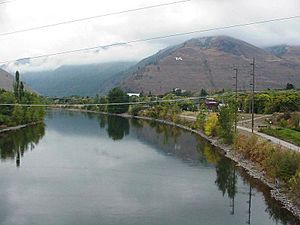
Interstate 90 runs east-west along the northern edge of Missoula. It has four exits in the city and connects with U.S. Route 93, U.S. Route 12, and Montana Highway 200. U.S. 93 is a major road for western Montana, linking Missoula to the Bitterroot Valley in the south and Kalispell and Glacier National Park in the north. Montana Highway 200 is the longest state highway in the U.S.
Public transportation in Missoula started in 1890 with horse-drawn streetcars. Today, Mountain Line provides bus service. It operates 14 bus routes in Missoula and nearby areas. They also offer services for people with disabilities and seniors. Since 2015, all Mountain Line buses have been free to ride!
For travel between cities, Jefferson Lines provides bus service.
Railroads and Bicycles
Train travel was available from 1883 until 1979 when Amtrak stopped its North Coast Hiawatha route. The old train station is now on the National Register of Historic Places. The closest Amtrak station to Missoula today is in Whitefish, about 136 miles north.
Missoula has a great system of trails for biking and walking, covering over 22 miles. The trails along the Clark Fork River connect downtown with neighborhoods, the university, and parks. Missoula is a very bike-friendly city. In 2009, it ranked fifth in the U.S. for the percentage of people who biked to work.
Missoula International Airport
Air travel to Missoula began in 1927. Today, Missoula Montana Airport serves the city. It's the largest airport in western Montana, serving over 913,000 passengers in 2023.
Notable People from Missoula
Missoula has been home to many famous individuals. People from Missoula are called "Missoulians."
In politics, Jeannette Rankin, the first woman in Congress, was born and grew up in Missoula. Senators Mike Mansfield, who was the longest-serving Senate Majority Leader, and Max Baucus, Montana's longest-serving U.S. Senator, both started their political careers in Missoula.
Famous athletes from Missoula include five Olympic medalists and Pro Football Hall of Fame Quarterback John Elway.
Filmmaker David Lynch, actor Dana Carvey, and biologist Leroy Hood were born in Missoula. Actors Carroll O'Connor and J. K. Simmons attended the University of Montana. Musician Jeff Ament and YouTuber Hank Green live in Missoula.
In literature, notable names include Native American poet James Welch and crime novelist James Crumley. Norman Maclean wrote A River Runs Through It, which tells stories about his life in Missoula in the early 1900s.
Sister Cities
Missoula has two sister cities:
 Neckargemünd, Germany
Neckargemünd, Germany Palmerston North, New Zealand
Palmerston North, New Zealand
Missoula's relationship with Palmerston North, New Zealand, started in 1983. Each May, Missoula celebrates "New Zealand Day" with rugby, food, and entertainment. The second sister city relationship with Neckargemünd, Germany, began in 1991. Every September, the Missoula Cultural Council holds an annual "Germanfest" to celebrate German culture and this connection.
See also
 In Spanish: Missoula (Montana) para niños
In Spanish: Missoula (Montana) para niños



